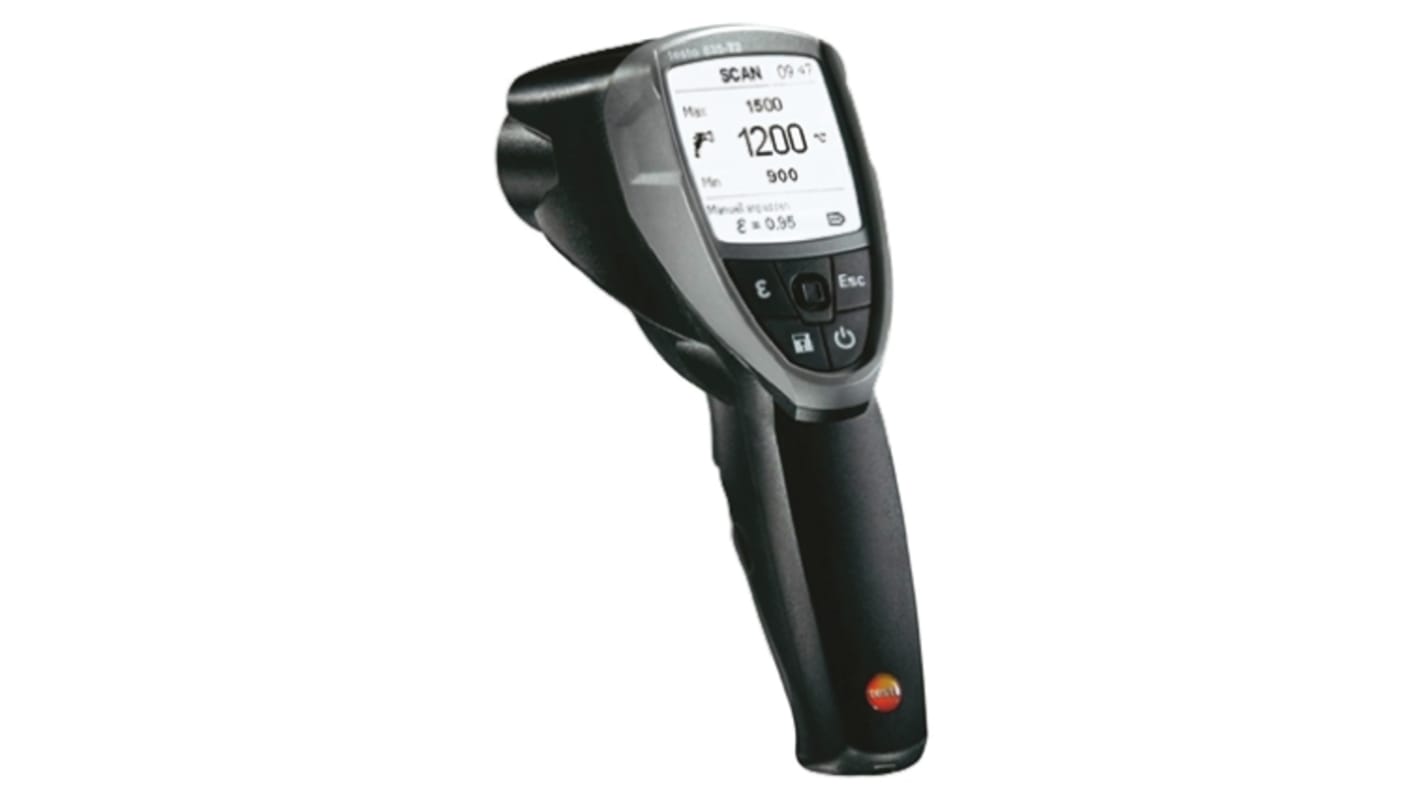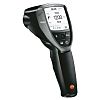Testo 835-T2 Infrared Thermometer, -10°C Min, +1500°C Max, ±1 %, ±2.0 °C Accuracy, °C Measurements
- RS Stock No.:
- 777-0434
- Mfr. Part No.:
- 0560 8352
- Brand:
- Testo

Subtotal (1 unit)*
£443.39
(exc. VAT)
£532.07
(inc. VAT)
FREE delivery for orders over £50.00
In Stock
- 4 unit(s) ready to ship
- Plus 2 unit(s) ready to ship from another location
Need more? Click ‘Check delivery dates’ to find extra stock and lead times.
Units | Per unit |
|---|---|
| 1 + | £443.39 |
*price indicative
Calibration Options:
- Calibration Type:
- RSCAL
- RS Stock No.
- 776-4903
Each
£546.89
(exc. VAT)
£656.27
(inc. VAT)
- RS Stock No.:
- 777-0434
- Mfr. Part No.:
- 0560 8352
- Brand:
- Testo
Specifications
Technical Reference
Legislation and Compliance
Product Details
Find similar products by selecting one or more attributes.
Select all | Attribute | Value |
|---|---|---|
| Brand | Testo | |
| Absolute Maximum Temperature Measurement | +1500°C | |
| Temperature Scale | Centigrade | |
| Suitable for Body Measurement | No | |
| Distance to Spot Ratio | 50:1 | |
| Best Accuracy | ±1 %, ±2.0 °C | |
| Absolute Minimum Temperature Measurement | -10°C | |
| Emissivity | 0.1 → 1, Adjustable | |
| Model Number p | 835-T2 | |
| Resolution | 0.1 °C, 1 °C | |
| Data Storage | Yes | |
| Length | 193mm | |
| Width | 166mm | |
| Height | 63mm | |
| Dimensions | 193 x 166 x 63mm | |
| Weight | 514g | |
| Select all | ||
|---|---|---|
Brand Testo | ||
Absolute Maximum Temperature Measurement +1500°C | ||
Temperature Scale Centigrade | ||
Suitable for Body Measurement No | ||
Distance to Spot Ratio 50:1 | ||
Best Accuracy ±1 %, ±2.0 °C | ||
Absolute Minimum Temperature Measurement -10°C | ||
Emissivity 0.1 → 1, Adjustable | ||
Model Number p 835-T2 | ||
Resolution 0.1 °C, 1 °C | ||
Data Storage Yes | ||
Length 193mm | ||
Width 166mm | ||
Height 63mm | ||
Dimensions 193 x 166 x 63mm | ||
Weight 514g | ||
RoHS Status: Exempt
- COO (Country of Origin):
- CN
Testo 835 T-2 Infrared Thermometer
For non-contact temperature measurements, the Testo 835 T-2 is specifically designed for trade and industry. Featuring a new processor it has better resolution and makes precise IR measurements possible. The 4-point laser thermometer has spot marking and 50:1 distance-to-spot ratio making the testing of small objects possible.
With a pistol style ergonomic design it also features adjustable limit values and alarm function. The T2 can measure precise temperatures of up to 1500°C from a safe distance with it's extended temperature measuring range.
With a pistol style ergonomic design it also features adjustable limit values and alarm function. The T2 can measure precise temperatures of up to 1500°C from a safe distance with it's extended temperature measuring range.
Features and Benefits:
• -10°C to 1500°C temperature range
• Fast readings
• Audible and visual alarms
• Back-lit display
• Adjustable emissivity 0.10 to 1.00
• Fast readings
• Audible and visual alarms
• Back-lit display
• Adjustable emissivity 0.10 to 1.00
FAQ's
Are infrared thermometers dangerous?
Infrared thermometers are not harmful, they do not emit radiation, only measure it like a digital camera.
How accurate are infrared thermometers?
The majority of IR thermometers have a measurement error specification, which shows their best accuracy. The surface being measured can also affect accuracy. Reflective objects result in lower measurements than the actual temperature, whilst non-reflective surfaces give higher measurement. The emissivity of a surface is how effective it is at emitting energy as thermal radiation, as such some IR thermometers have adjustable emissivity settings.
Distance to spot ratio is also essential in providing accurate temperature measurements, if an infrared thermometer is too close to its target area, heat can build up in the device. This can give false readings or damage the temperature sensors, therefore it is essential to always follow a manufacturers guidelines.
Distance to spot ratio is also essential in providing accurate temperature measurements, if an infrared thermometer is too close to its target area, heat can build up in the device. This can give false readings or damage the temperature sensors, therefore it is essential to always follow a manufacturers guidelines.
Supplied with
3 batteries Type AA and calibration protocol
Testo Digital Non-Contact Infrared Thermometer, 514g, +1500°C Maximum Temperature - 835 Series - 0560 8352
Looking for a way to accurately measure temperatures from a safe distance? Turn to this non-contact infrared thermometer from Testo. Designed with precision in mind, this 4-point laser instrument has a distance-to-spot ratio of 50:1 for measuring both large and small objects. The device features a data storage system for quick data retrieval and comparison. An audible alarm alerts you when temperatures rise or fall above a certain level to aid in temperature control. For enhanced reliability, it has a reading accuracy of ±2.0°C. Its ergonomic, handheld design makes it simple to use.
Features & Benefits
• Wide temperature measurement range of -10°C to +1500°C for use in demanding environments
• Supplied with three AA batteries and calibration protocol for simple set-up
• Adjustable emissivity of 0.10 to 1.00 for reading accuracy
• Backlit display for easy temperature reading in dark or dimly lit areas
• Supplied with three AA batteries and calibration protocol for simple set-up
• Adjustable emissivity of 0.10 to 1.00 for reading accuracy
• Backlit display for easy temperature reading in dark or dimly lit areas
Applications
• Industrial environments
• Machinery temperature control
• Manufacturing applications
• Machinery temperature control
• Manufacturing applications
When should I use an infrared thermometer?
As an infrared thermometer doesn't require contact with an object, it's a good choice when you need to measure the temperature of something that's difficult or unsafe to access.
Related links
- Testo 835-T2 Infrared Thermometer ±1 % °C Measurements With RS Calibration
- Testo 835-H1 Infrared Thermometer +600°C Max ±1.5 °C °C Measurements
- Testo 835-T1 Infrared Thermometer +600°C Max ±1.5 °C °C Measurements
- Testo 830-T2 Infrared Thermometer +400°C Max °C Measurements
- Testo 104-IR Infrared Thermometer +250°C Max ±1 °C ±2.5 °C Accuracy, °C Measurements
- Testo 104-IR Infrared Thermometer +250°C Max ±1.5 % ±2.5 °C Accuracy, °C Measurements
- Testo 835-H1 Infrared Thermometer +600°C Max ±1.5 °C °C Measurements With RS
- Testo 835-T1 Infrared Thermometer +600°C Max ±1.5 °C °C Measurements With RS

